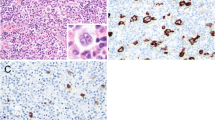Abstract
In situ hybridization (ISH) to Epstein-Barr virus (EBV)-encoded RNA (EBER) is considered the “gold standard” for detecting and localizing latent EBV in biopsy samples. Transcripts from the EBER1 and EBER2 genes are an appropriate target because they are the most abundant viral RNA in latently infected cells, exceeding 1 million transcripts per cell. Furthermore, EBERs are consistently expressed in virtually all EB V-infected tumors and in the lymphoid tissues of infectious mononucleosis (1–5). As a result, EBERs represent a naturally amplified target for detecting and localizing latent EBV in histologic samples. The only EBV-related disorder in which EBER is consistently absent is oral hairy leukoplakia, an infection of squamous epithelial cells in which the virus undergoes lytic viral replication rather than latent infection (6).
Access this chapter
Tax calculation will be finalised at checkout
Purchases are for personal use only
Similar content being viewed by others
References
Wu, T. C., Mann, R. B., Epstein, J. I., MacMahon, E., Lee, W. A., Charache, P., Hayward, S. D., Kurman, R. J., Hayward, G. S., and Ambinder, R. F. (1991) Abundant expression of EBER1 small nuclear RNA in nasopharyngeal carcinoma: a morphologically distinctive target for detection of Epstein-Barr virus in formalin-fixed paraffin-embedded carcinoma specimens. Am. J. Pathol. 138, 1461–1469.
Wu, T. C. and Kuo, T. T. (1993) Study of Epstein-Barr virus early RNA-1 (EBER1) expression by in situ hybridization in thymic epithelial tumors of Chinese patients in Taiwan. Hum. Pathol. 24, 235–238.
Gulley, M. L., Eagan, P. A., Quintanilla-Martinez, L., Picado, A. L., Smir, B. N., Childs, C., Dunn, C. D., Craig, F. E., Williams, J. W., and Banks, P. M. (1994) Epstein-Barr Virus DNA is abundant and monoclonal in the Reed-Sternberg cells of Hodgkin’s disease: association with mixed cellularity subtype and Hispanic American ethnicity. Blood 83, 1595–1602.
Reynolds, D. J., Banks, P. M., and Gulley, M. L. (1995) New characterization of infectious mononucleosis and a phenotypic comparison with Hodgkin’s disease. Am. J. Pathol. 146, 379–388.
Ambinder, R. F. and Mann, R. B. (1994) Epstein-Barr encoded RNA in situ hybridization: diagnostic applications. Hum. Pathol. 25, 602–605.
Gilligan, K., Rajadurai, P., Resnick, L., and Raab-Traub, N. (1990) Epstein-Barr virus small nuclear RNAs are not expressed in permissively infected cells in AIDS-associated leukoplakia. Proc. Natl. Acad. Sci. USA 87, 8790–8794.
Barletta, J. M., Kingma, D. W., Ling, Y., Charache, P., Mann, R. B., and Ambinder, R. F. (1993) Rapid in situ hybridization for the diagnosis of latent Epstein-Barr virus infection. Mol. Cell. Probes 7, 105–109.
Ambinder, R. F., Browning, P. J., Lorenzana, I., et al. (1993) Epstein-Barr virus and childhood Hodgkin’s disease in Honduras and the United States. Blood 81, 462–467.
Randhawa, P. S., Jaffe, R., Demetris, A. J., Nalesnik, M., Starzl, T. E., Chen, Y. Y., and Weiss, L. M. (1992) Expression of Epstein-Barr virus-encoded small RNA in liver specimens from transplant recipients with post-transplantation lymphoproliferative disease. N. Engl. J. Med. 327, 1710–1714.
Montone, K. T., Friedman, H., Hodinka, R. L., Hicks, D. G., Kant, J. A., and Tomaszewski, J. E. (1992) In situ hybridization for Epstein-Barr virus NotI repeats in posttransplant lymphoproliferative disorder. Mod. Pathol. 5, 292–302.
Author information
Authors and Affiliations
Editor information
Editors and Affiliations
Rights and permissions
Copyright information
© 2001 Humana Press Inc.
About this protocol
Cite this protocol
Fan, H., Gulley, M.L. (2001). Molecular Methods for Detecting Epstein-Barr Virus (Part I). In: Killeen, A.A. (eds) Molecular Pathology Protocols. Methods in Molecular Medicine™, vol 49. Humana Press. https://doi.org/10.1385/1-59259-081-0:301
Download citation
DOI: https://doi.org/10.1385/1-59259-081-0:301
Publisher Name: Humana Press
Print ISBN: 978-0-89603-681-9
Online ISBN: 978-1-59259-081-0
eBook Packages: Springer Protocols




